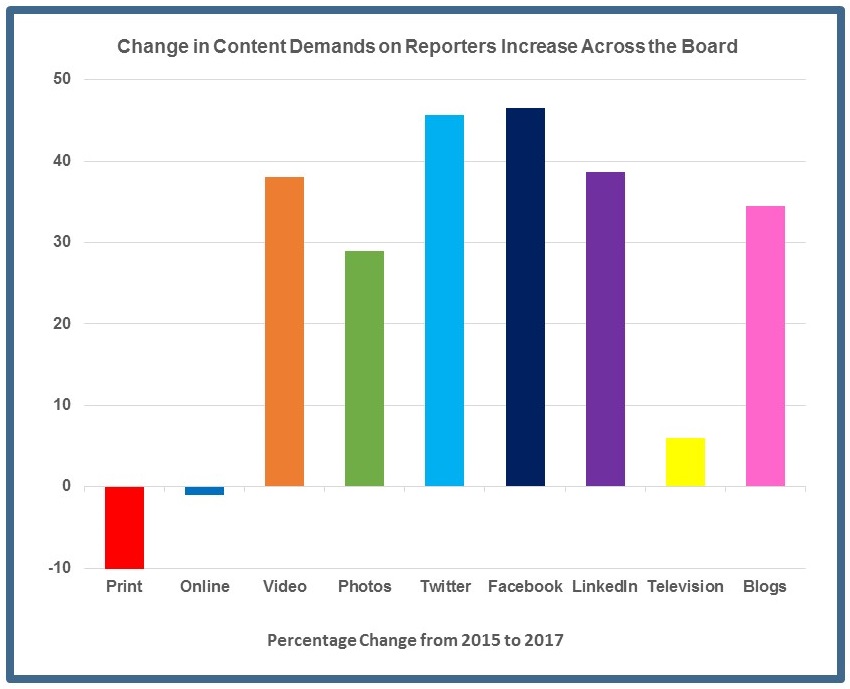880 W. Long Lake Road • Suite 225 •
Troy, Michigan 48098
• P: 248.269.1122 •
E: bianchipr@bianchipr.com
Reporters’ Duties Growing with Social/Digital; Creating New PR Opportunities

Journalists are facing increasingly intense pressure to produce multimedia stories and to build engagement for their stories on social media, according to a recent Public Relations Global Network (PRGN) survey of more than 110 journalists around the world. And these changes are creating new opportunities for PR professionals to boost their coverage and enhance their media relationships.
In terms of news content, the PRGN survey showed:
– 89 percent of reporters are now required to provide basic online content (virtually unchanged from two years ago),
– Only 57.3 percent of respondents are being asked to provide print content (down from 67.6 percent two years ago),
– 49.1 percent of reporters said they are now required to provide visual content such as graphics and video (36 percent two years ago), and
– 29.1 percent are required to provide photos (22 percent two years ago).
In addition, social media requirements for reporters are increasing rapidly across all platforms compared to two years ago, when the PRGN survey was last conducted:
– 55.5 percent must now post stories to Facebook (up from 37.8 percent);
– 47.3 percent must Tweet on Twitter (up from 35.4 percent);
– 20 percent must post on LinkedIn (up from 14.4 percent); and
– 14.6 percent are required to post blog content (up from 10.8 percent).
What this shift means for PR professionals
First, these additional content requirements for journalists mean that already time-pressed reporters will have even less time to spare. The more efficient you can make your interactions with them, the more you can help them … and the more often they will come back to you for stories.
Make sure your online newsroom is current with up-to-date fact sheets, backgrounders, press releases, images and videos so they have access when you’re not working. Respect their time and their deadlines. Give them easily digestible and usable information, as well as graphics, photos, contacts and perspective they need to do their story.
Make sure your subject matter expert (SME) is available right after you make your pitch or issue your press release, so the journalists can get the quotes they need quickly. If they need to take fresh photos, have your SME, product and a striking setting for a photo shoot ready to go. Nothing helps a good story – especially an online story – more than a great photo or visual.
Second, realize just how important digital and social media sharing has become for journalists. Numerous journalists have told us that the online and social clickability of a story is becoming a big factor in editorial assignment decisions. For example, a reporter for a major Detroit newspaper told us that his paper did a second story on a unique delivery vehicle one week after the paper covered the vehicle’s national launch, because the national launch story had generated such great viewer engagement online.
Consider the fact that more people read the Wall Street Journal online than read the print version, as well as the fact that the WSJ’s “Recommended Videos” are among the most popular stories featured online.
Reporters for nationally known media outlets have also told us they are increasingly being evaluated based on the number of likes, shares and comments their stories generate online.
Knowing this growing importance of digital and social media, PR professionals should:
– Follow the Facebook, Twitter and LinkedIn feeds of your key target media outlets and reporters;
– Check our your media target’s online presence before you pitch, so you get a better feel for their approach, style and focus;
– Share, like and comment on Facebook, Twitter and LinkedIn posts of the outlet’s and reporter’s stories; and
– Amplify any media coverage you get by promoting it on your own personal and company social media outlets and website, extending the stories’ reach and leveraging the outlet’s credibility.
One last point: While social media is not the first source that journalists go to when conducting research before a CEO interview, it IS growing in importance globally, with 21 percent of journalists saying they use it as one of their top three sources. As more young social-media savvy professionals join journalism’s rank, this trend is likely to accelerate.
We will share more data and analysis from the PRGN global journalist survey in future posts.